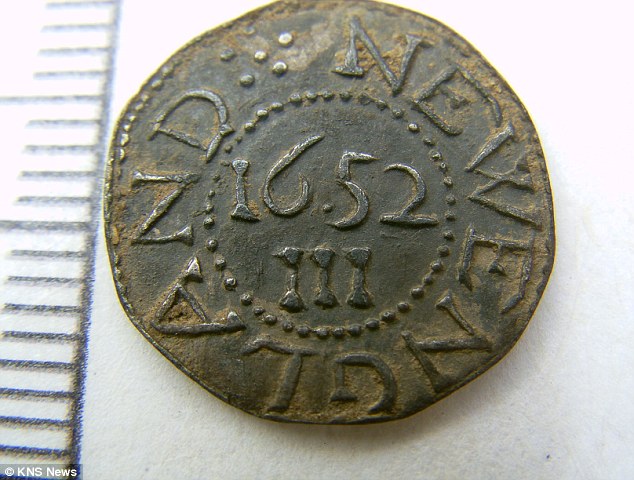Mail Online |By Paul Harris Reports For The Daily Mail | September 5, 2014

• John Stoner, 42, dug up the the rare coin in a field in Nottinghamshire
• Father-of-two had only just started to search field when he picked up signal
• It’s unknown how the coin ended up in the village of King’s Clipstone
• Has been hailed as one of the finest examples of currency produced in the days of the Pilgrim Fathers
When it was minted 350 years ago, there wouldn’t have been much change from a slap-up meal and a few of pints of ale.
Today the silver threepenny coin that amateur treasure-hunter John Stoner dug up in a farmer’s field would probably buy the entire farm.
The extremely rare New England coin, bearing the date 1652, is expected to sell for up to £1million when it is auctioned.
It has been hailed as one of the finest examples of a currency produced in the days of the Pilgrim Fathers in a land that would become the United States.
How the 17th century threepenny bit ended up in the village of King’s Clipstone, Nottinghamshire, is not known but last night coin collectors from around the world clamoured to buy it.
Mr Stoner, who temporarily mislaid the coin at one point, found it while on an outing with the Coil To The Soil metal detector club on Sunday.
The 42-year-old father of two had only just started to sweep an area of the ploughed field when he picked up two signals from the detector.
The first was from a random piece of metal; the second was from an uneven, hand-hammered coin, about the size of a modern 1p but thinner, buried five inches deep in a clod of earth.
‘I dug up the soil and out it popped,’ he said of the historic find. ‘At first I didn’t think it was anything special. I knew it wasn’t English, but just how important a find it was, I didn’t have a clue.’
The club immediately posted a picture of the coin on its Facebook page and invited followers to identify it. Within five minutes, they were inundated with replies. One enthusiast wrote: ‘Your mate has just won the lottery!’ That evening Mr Stoner took it to his Worksop home, put it in a jar and showed it to friends. In the morning, he couldn’t find it. ‘I must have knocked the jar over,’ he said. ‘It rolled on the floor somewhere but I just left it there when I went out. I had to look around for it when I came back.’
On Monday, coin expert Peter Spencer confirmed it was a genuine threepenny piece from the first authorised colonial coinage, commissioned and struck in Boston, Massachusetts.
‘I handed it over to him and I think it’s fair to say he went white as a ghost,’ Mr Stoner said. ‘He said its condition was like the day it was struck.’
It was made by placing a blank silver disc on an engraved die, sandwiching it with another die for the reverse side, then hitting it with a hammer.
The III in Roman numerals shows its denomination to differentiate it from tuppence, sixpence and shilling coins. Although it bears the date 1652, the oak tree on one side shows could have been minted in any year between 1653, when the original simpler design was changed to beat counterfeiters, and 1682, when a new series of coins was introduced.


Because it is a single coin, it is not subject to treasure trove laws which mean finds have to be reported to a coroner and handed to the Crown. Last night it was on its way to the US for expert cleaning before being offered for sale by St James’s Auctions in London on December 2.
Five years ago a less spectacular colonial Massachussetts coin was sold for $430,000 (about £265,000). One US auction house estimated Mr Stoner’s could fetch $1.7million – just over £1million.
Mr Spencer said the coin was ‘a phenomenal find’, not only because of its rarity but because it had survived undamaged.
Some coins of that era were ‘short changed’ by filing or clipping silver from the edges to sell. He said it might have come to England as part of 17th century transatlantic trading. A good tradesman would earn about five shillings (25p) a week in those days – so threepence would have seen him fed in fine style.
Not quite as fine as that which might await Mr Stoner, if the coin reaches its highest valuation. The self-employed IT consultant plans to split the proceeds with the farmer. ‘I think there’ll be enough to buy me some new clothes and pay a few bills,’ he said.



